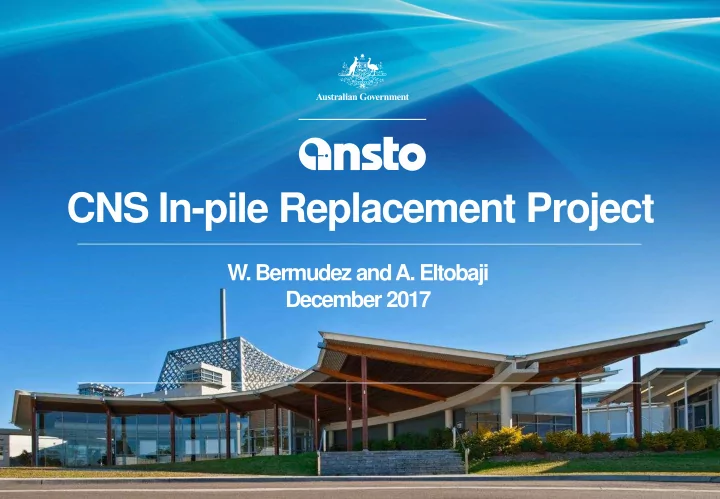

CNS In-pile Replacement Project W. Bermudez and A. Eltobaji December 2017
What is the project? • To replace the Cold Neutron Source (CNS) as it is approaching the end of its design life. The CNS In-Pile is a 3m tall structure and it goes here CRYO-PIPE CORE PCS PIPE
Why do we need to replace it? • Moderator vessel is made from AlMg5. • Thermal neutrons cause damage to Al alloys through transmutation – Al transmuted to Si. • Si is insoluble in Al and will form particles or potentially Mg2Si particles – solution hardening. • Fast neutrons displace Al atoms from their initial lattice position => point defects and dislocations => more susceptible to cracking.
Life extension of the CNS In-pile • Manufacturer’s rated design life is 10 years at full power. This will come in early 2019. No real data for AlMg5 in this • environment for >10 years operation. NSTLI – Materials - report concluded • that manufacturing defects and/or operational defects are not likely to be of sufficient size to result in critical crack instability after 15 years of operation. • weld residual stress (WRS) and the decreasing irradiation toughness are the major parameters in determining critical crack sizes.
Installation schedule We are Target here 2017 2018 2023 2024 2014 2015 2016 Installation Phase Project Initiation and Scoping Phase Design and Build Phase Initiate and Scoping Concept design Manoeuvre definition Funding Case Long RFT Shutdown Detailed Engineering – In-pile and mockup Construction and procedure development Licensing Documentation Training Installation
CNS Mk2 – how is it different? Conceptual designs based on calculations • benchmarked by measurements. Possible gains of 11% to 35% in source • brightness at the long wavelengths (> 8Å). 1,50 1,40 case2 case3 1,30 case4 Ratio 1,20 1,10 Case 1 as reference datum Case 3 was selected 1,00 0,90 2,00 4,00 6,00 8,00 10,00 12,00 14,00 Wavelength λ (Å)
Manoeuvre development - Constraints ANSTO dose limit – 15 mSv/year per person 1. Project dose constraint – 10 mSv for any individual 2. Project dose target – 5 mSv per person 3. Design target – 2.5 mSv per person 4. • CNS Replacement project - 25 mSv.man • Expect to need 9 persons minimum (based on radiation dose). Fatigue, dehydration, etc. may affect this number. • Expect to operate on 2 extended shifts (10 hours) per day (this setup was used successfully with Cold Guide 2 installation in 2012) .
The original CNS installation
What is different now? There will be residual heat within the walls Likely radioactive contamination Need to remove everywhere! all the pipework and support bracket in order to remove the Background CNS in-pile radiation ~100µSv/hr. (Based on previous tasks) Need to remove these nuts It’s a confined 120mSv/hr at space! contact! The top flange of the CNS is here
Manoeuvre development methodology 1. ALARA 2. High automation (low dose, complexity and cost) vs low automation (higher dose, less complexity) 3. Some tasks would be hard to automate e.g. welding pipes, removing certain nuts with limited access, seal groove preparation, etc. 4. The decision was to automate repetitive tasks and manually perform the complex tasks. This means using distance (long tools), shielding and optimising the duration of the tasks.
Manoeuvre development • Manoeuvre development step-by-step in mock-up (no radiation PPE) • Manoeuvre development step-by-step in mock-up (with radiation PPE) (with ANSTO WHS and Radiation protection assistance) • Abnormal operations and recovery scenarios • Training before installation Simulation of rescue scenarios
5 main steps to the manoeuvre 1. Reactor shut down, process set up for opening and Level 13 preparation (pool top area) Purge the lines, bring components and tools to Level 13 Remove silicon rack, protection covers and other sensitive equipment Line the area with plastic 2. CNS removal, CNS disassembly and final storage 3. New CNS assembly and reactor pool preparation 4. New CNS installation in reactor pool 5. CNS testing, cold and hot commissioning
Removal of the existing CNS • Shielded workbox Need to cut for a person to pipes here enter the pool. • Use the water as shielding. • Drop water level to as low as +4300 (just under the CNS flange) depending on the task.
Removal of the existing CNS • Shielded workbox can be configured for different tasks.
Removal of the existing CNS Cutting of vacuum and deuterium lines – improvements for future replacements. Disconnection and cutting of heavy water lines – improvements for future replacements.
Removal of the existing CNS CNS flange unbolting/bolting
Removal of the existing CNS Attachment of lifting equipment to CNS Overall weight of assembly ~600kg
CNS Pipework Disassembly LEVEL 13 Control Room wall Shielded support LEVEL 10 Pool wall CNS Storage Pipework for the new CNS in-pile is assembled here too.
CNS Installation – Alignment device CNS ready for insertion Electrical cylinder 100 mm lead Shielding ~300 kg Guides for CNS (polypropylene)
CNS Installation – lifting of new CNS New pipe support frame and lifting device to allow for one motion insertion.
Mock-up of reactor pool and CNS Mock-up built - Full-scale ½ pool • To be used to develop the procedure. • • Will be used to train technicians
Mock-up of reactor pool and CNS Development of the manoeuvre has • commenced.
Thank you
Recommend
More recommend